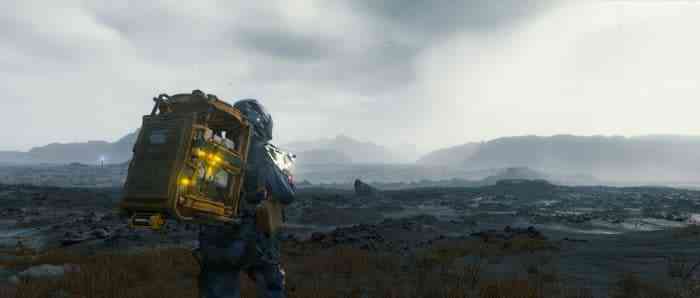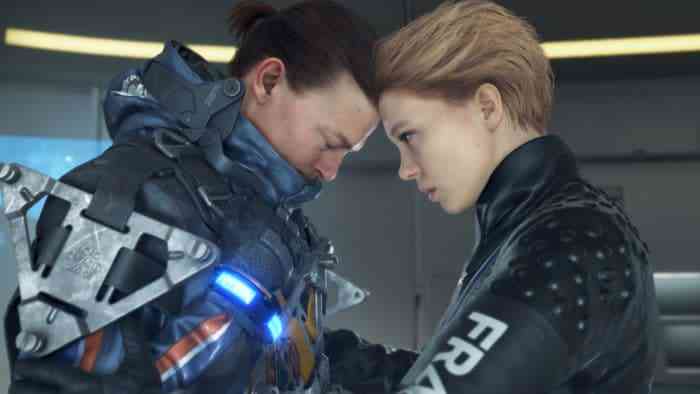The Pandemic Papers: Stranded Alone, Together.
This has been a long year. As we in Vancouver, and many elsewhere in the world, prepare to head into another period of restricted travel, it is with a sense of weariness…this again? Mingled with that weariness, however, is hope. We made it through last time, we will do so again, and what is more – this time we know what to expect. It seems as good a time as any to share some resources; the games and stories that offered a light in the darkness, a simple escape, or a moment of meaning. We hope that if you are reading this and find yourself in need of a lift, then you might find inspiration in The Pandemic Papers…
The wind pummels me from the right, to my left a sheer drop. A hefty load of cargo sways on my back, pulling me off-centre, and my shoes are about to dissolve. Things are just about as bad as they can get, but then the rain starts, and the rain brings monsters.

Death Stranding is filled with moments like these, completely player-driven instances of life or death, a masterfully crafted gameplay experience that balances long pensive periods of quiet with sudden instances of terror and awe. The Playstation 4 exclusive (now available on PC) came highly anticipated after auteur director Hideo Kojima’s very public split with Konami – the producers of his wildly successful Metal Gear series. With only a few cryptic trailers to go on, I had no idea what to expect when I ordered this game. As I sat stranded on my couch in the middle of lockdown, I certainly did not expect Death Stranding to be a transcendent experience, and perhaps the perfect pandemic game.
“… that which you cannot see is most frightening of all.”
The story of Death Stranding is oblique from the start. The player is simply dropped into the middle of the action somewhere on the Eastern seaboard of America after some sort of cataclysm has wiped out huge swathes of the population. The wide open spaces of this near-post-human landscape are immediately striking, with a palette of greens and greys that are soothing and inviting. The surviving humans have become isolated – retreating into a few disparate cities or else completely cutting themselves off to live in underground bunkers. It is no virus that has driven mankind to the brink, but rather the “Beached Things” – invisible monsters trapped between the worlds of the living and the dead. Much like a virus, however, the beached things employ the greatest truism of horror cinema – that which you cannot see is most frightening of all. There is no way Kojima could have predicted the lockdown, but from its beginning Death Stranding simultaneously fulfils the fantasy of being in the great wide open, while also throwing into sharp relief the disconnectedness and isolation we were all feeling in those first few weeks of March.
Our hero, Sam Porter Bridges, is known as “the great deliverer”, a courier who is willing to brave the outside world to bring essential supplies to these far flung communities and settlements. He moves from one distribution centre to the next, piling boxes high on his back and the player must balance both figuratively, the risks and rewards of each package and, literally by distributing weight so that they can navigate the uneven landscape.
Even before the pandemic busy people were relying on deliveries of everything from toiletries to food to arrive at their doorstep, Kojima’s twist on our online-ordering addiction offers a satirical glance at where our society may be headed. He might not even be that far off, as a Chinese delivery company has already tested out an exo-skeleton reminiscent of the one Sam uses in the game. Since the advent of Covid-19, this global network of couriers has only become more important, with many praising the work of those delivery drivers genuinely taking on personal risk to keep us supplied. Playing this game during lockdown, this parallel was inescapable from the very moment I took the game from the courier at my door.
“Never in a game have I felt more in tune with every step.”
Not only does Death Stranding ask you to carry bulky loads across a demon infested America, it asks you to do this while carrying an adorable baby in a bell jar. Sam is first given his Bridge Baby, or BB for short, and told to think of it as nothing more than a piece of equipment – a tool for detecting the invisible monsters that plague the world. To think of BB as just a tool (or even just as the lines of code that in reality it is) was completely impossible for me. Instantly I cared for BB, scrambling to soothe its cries whenever I took a tumble, and feeling a swell of joy whenever it giggled or laughed.
Never in a game have I felt more in tune with every step, as if I were carrying a real child – terrified that the ground might give way. As Sam fights to unite the nation and secure its future, all while carrying a child, I could not help but think about our own world, and the future that we are building. Games so often position us as the saviour, the only one who can rescue the world from the brink, but usually they also grant you power and a complete lack of consequence. Death Stranding, by contrast, puts only obstacles in your way, and every step you take towards your goal you are accompanied by a reminder of the innocence you are trying to protect as BB coos away.

In a lengthy cinematic sequence (which fans have come to expect from Kojima – a man whose twitter bio claims “70% of my body is made of movies”) it is explained that the circumstances that lead to this world’s slow apocalypse also gifted it with the Chiral Network, essentially allowing almost any non-organic structure to be 3D printed in seconds. From bridges to motorcycles to weapons, the Chiral Network is a marvel that allows the remnants of humanity to build with ease, however most of the USA is not connected. So Sam is sent on a cross country trip, across arid rocky landscapes, swamps, and mountains, to connect the remaining settlements of America and bring them into the network. As the player explores, they quickly realise that not everyone wants to sign up. There is abundant distrust of the forces trying to unite the nation, and a general resignation to the way things are. On a one man mission to bring progress to the far-flung reaches of the country, Sam meets surprising resistance that brings to mind some of the challenges we face in our real world. As I carried vital components through a valley filled with wind turbines, or used the Chiral Network to build roads across difficult terrain, Kojima’s imagined future of technological wonders felt like an idyllic version of where we may be headed, but even in our invented worlds we face challenges to living in harmony with one another.
“A feeling of connection at a time when I needed it the most.”
The Chiral Network is the evolution of an idea Kojima first began playing with in Metal Gear Solid V: The Phantom Pain. In MGSV players are tasked with building up an army, and are given the opportunity to acquire nuclear weapons. Kojima, fiercely anti-nuclear weapons, built a secret ending into the game that was only possible if players could link up online and rid the world of nuclear weapons. Death Stranding takes this cooperative spirit a step further, and as Sam builds up the Chiral Network not only is the player networking the cities in their own game, but they are accessing the work of other players around the world. Suddenly, you are not only building bridges for yourself, but contributing to the projects of others.

Players can leave signs for each other to point out difficult areas to traverse, or else just a thumbs up and an encouraging “hang in there”! This felt gimmicky at first, but soon I learned to love sharing my game, and my in-game currency of materials and likes. While you never see the other players in your network, you feel their presence through your shared mission to connect the world. This was a profound experience for me as a player who almost never plays online. I like my games to be personal, I like to control my own pace, I like to play my way. Kojima’s approach to cooperative play is radically different, and I soon found myself changing the way I played to better suit the community. Instead of hoarding materials (as I would in any other game) I would donate any spare to the nearest construction project. Instead of ignoring the online component of the game, it became a huge part of my enjoyment, and a feeling of connection at a time when I needed it the most.
“Networks are what make us human.”
Death Stranding is a strange game. Its story is oddly paced, and its mechanics fly in the face of traditional wisdom about what makes something fun. However, 2020 has been a strange year, and perhaps traditional wisdom ought to be thrown out in favour of thinking differently.
At the time of writing, things are improving, and going outside is a little easier every day. However, thanks to my experience with this game, I understand more than ever that a network is not just a means to distribute goods, nor a commodity to sell, and certainly not an optional extra feature to be ignored. Death Stranding made me appreciate that networks are what make us human, connecting us to each other even in times when we desperately want to shut ourselves away. Video Games are a young industry, and experienced developers like Kojima right now are carrying it like I carried my BB, towards what is assuredly going to be a much more connected, and hopefully brighter, future.
I would love to hear about your experiences gaming throughout the pandemic, feel free to share in the comments.